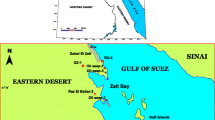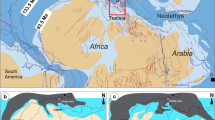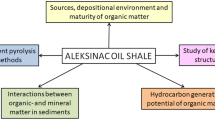Abstract
Fifteen oil seepage and solid bitumen samples in the Southern Guizhou Depression were analyzed with GC–MS. Characteristics of molecular markers and carbon isotopes are discussed systemically. The results showed that the oil seepage and solid bitumen samples in the Southern Guizhou Depression could be divided into two families: Ordovician and Siluric samples, and Permian samples. The two families are different in alkanes distribution, biomarkers, aromatic hydrocarbon composition, and stable carbon isotopes; differences mainly caused by source rock variation.
Similar content being viewed by others
Explore related subjects
Discover the latest articles, news and stories from top researchers in related subjects.Avoid common mistakes on your manuscript.
1 Introduction
From the 1950s, Lower Paleozoic fossil and remnant reservoirs were found in the Southern Guizhou Depression and its peripheral area in the southeast of Guizhou province (Fig. 1). Superficial drilling proved that Ordovician and Silurian strata contained oil and gas in upper composite anticlines. In the 1970s, the “number 8” geological reconnaissance team discovered the Majiang fossil reservoir and Kaili remnant reservoir in which remained 3.53 × 108 t of residual bitumen; they estimated original reserves were 16 × 108 t (Han and Wang 1983).
As a part of the Yangtze platform, the Southern Guizhou Depression and its peripheral area are similar to other parts of China in terms of sedimentation, structure, generation, and accumulation which have combined to make the region a favorable area to discover large and medium oil and gas fields. Analysis of the fossil and remnant reservoirs could direct the exploration of marine carbonate strata in Southern China. Previous studies have not reached consensus on oil sources and stages of accumulation (Ma et al. 2004; Zhang et al. 2007; Gao and Liu 2008; Tenger Qin and Zheng 2008). In this paper, geochemical characteristics of the Paleozoic oil seepage and solid bitumen in the Majiang and Kaili areas are analyzed in detail, and oil–oil correlation and families are discussed. Four oil seepage samples and eleven solid bitumen samples of the Southern Guizhou Depression were collected and analyzed by GC–MS; molecular markers of samples are correlated elaborately. According to the oil-correlation, geochemical alterations via generation, migration, and accumulation of crude oil are recognized which could help analyze oil sources and direct exploration deployment.
2 Methods
2.1 Geological background
The Majiang fossil reservoir and Kaili remnant reservoir are both in known petroleum systems which have integrated source rock, reservoir, cap rock, and overlying strata (Fig. 2). The fossil reservoir and remnant reservoir are located in the east of the Southern Guizhou Depression (Fig. 3). The sedimentary characters are complex and include typical platform facies and basin facies with transitional slope facies. There are several vertical groups of petroleum systems caused by tectonic activity. The petroleum system of the Majiang fossil reservoir is sourced from the Lower Cambrian basin facies mudstone, held in Lower Ordovician and Silurian Wengxiang Group platform facies reservoirs, and sealed by the Silurian fourth member of the Wengxiang Group shore facies mudstone. Different from Majiang, the petroleum system of the Kaili remnant reservoir is sourced from the first member of the Wengxiang Group foreshore facies mudstone, held in the second and third members of the Wengxiang Group shore facies sandstone, and sealed by the fourth member of the Wengxiang Group mudstone. The structure of the oil trap in the southeastern Guizhou province formed by Duyun movement and Guangxi movement in the Caledonian orogeny, altered and damaged by Yanshan movement and Sichuan movement in the early Himalayan period (Han and Wang 1983; Zhang et al. 2007; Gao and Liu 2008; Xiang et al. 2008).
Eight Paleozoic sections of the Majiang and Kaili areas were observed, and fifteen oil seepage and solid bitumen samples were collected (Fig. 3). The sample from the Kaili H47 well is light oil; the Kaili Lushan Ordovician oil seepage is in limestone geode and Permian oil seepage occurrence is leaching. The samples were crushed, extracted, and separated into four fractions (saturated hydrocarbon, aromatic hydrocarbon, non-hydrocarbon, and asphaltene). Saturated and aromatic hydrocarbon GC–MS and isotope analysis were performed.
2.2 Method
Analysis of saturated and aromatic hydrocarbon GC–MS was conducted using Agilent 6890 gas chromatograph coupled with 5975i mass spectrometry, equipped with HP-5MS silica capillary column (standard is GB/T18606-2001). GC conditions: carrier gas is helium with a concentration of 99.999 %; the temperature of the injection port and transfer line is 300 °C with a heating program that consists of holding at 80 °C for 1 min, heating up to 310 °C at a rate of 3 °C per minute, and holding for 16 min. MS conditions: electron impact mode is 70 eV; filament current flow is 300 μA, and multiplier voltage is 1,200 V, full scan.
3 Results
3.1 Gross compositions
Saturated and aromatic hydrocarbons comprise the majority in oil seepage samples. The ratio of saturated hydrocarbon to aromatic hydrocarbon (S/A) of the Kaili Lushan Permian oil seepage is low at 0.75; three other oil seepage samples have ratios of 2 to 3. Solid bitumen’s major fractions are non-hydrocarbon and asphaltene; the S/A ratio of solid bitumen in the Kaili and Majiang areas is low. The Majiang Ordovician and Lushan Silurian solid bitumen are rich in saturated and aromatic hydrocarbon fractions, in contrast to other bitumen samples. The asphaltene fraction of Duyun Devonian solid bitumen is high at 94.49 % (Table 1).
In general, oil seepages are rich in saturated and aromatic hydrocarbon fractions in comparison to solid bitumen samples (the Majiang Ordovician and Lushan Silurian samples are exceptions). The S/A ratios of upper Paleozoic samples are low at 0.24 to 0.75; lower Paleozoic samples from the Majiang area are high at 5.13 to 18.
3.2 Saturated hydrocarbons
3.2.1 n-Alkanes and acyclic isoprenoids
As the most abundant of saturated hydrocarbon, n-alkanes provide key information about geochemical character which provides insight into organic matter types, sedimentary environment, thermal evolution stage, and biodegradation (Tissot and Welte 1984; Zhang et al. 2005; Yang et al. 2006).
C13–C24 alkanes dominate oil seepage and solid bitumen samples, although alkanes range from C11 to C36 with a single peak. On average the C21 −/C22 + ratio in the Majiang area is 2.88, higher than the Kaili area with a ratio of 1.79. CPI and OEP values are all around at 1.0 which indicates for mature stage (Table 2).
The concentration of isoprenoid alkanes is second to n-alkanes in crude oil. Pr/Ph, Ph/nC18, and Pr/nC17 could indicate organic facies and maturity (Mei and Liu 1980; Peters and Moldowan 1993). The values of Pr/Ph in the southern Guizhou Depression are distributed from 0.62 to 1.44, with an average of 1.13 in the Duyun area, which displays higher ratios than the Majiang and Kaili areas. Ph/nC18 and Pr/nC17 exhibit the typical character of marine crude oil (Fig. 4).
The correlation plate of Pr/Ph and DBT/PH built by Hughes could provide information about the lithology and sedimentary environment (Hughes et al. 1995). DBT/PH values of Permian samples in the Kaili Lushan and Mjiang areas are greater than 2, and the lower Paleozoic samples are less than 1 (Fig. 5).
3.2.2 Steranes
C27 regular sterane is from plankton; C29 regular sterane is from phytoplankton and higher plants. C27, C28, and C29 regular sterane distribution could reflect sources of sedimentary organic matter which is significant to the study of oil source, so the composition of sterane series is utilized to divide samples by genetic type (Peters and Moldowan 1993).
The relative content of C27 regular sterane is 13 %–69 %, PH-1 is too low and is caused primarily by secondary alterations and not by a different source (Fig. 6). The Permian samples in the Lushan area are low, in contrast to the lower Paleozoic samples. Distinct oil source is the main control factor, and the lower Paleozoic samples’ regular sterane distribution is like an asymmetric “V” (C27 > C28 < C29).
3.2.3 Terpanes
Tricyclic terpane and hopane are very important biomarkers in crude oil. The ratio of C21/C23 tricyclic terpane and C24 tetracyclic terpane/C26 tricyclic terpane can provide information about maturity and migration (Huang et al. 1987). Tricyclic terpane content of collected samples is high and dominated by C23TT; the C21/C23 tricyclic terpane ratio is less than 1. The C24 tetracyclic terpane/C26 tricyclic terpane ratio of the Lushan Permian samples is greater than others (Fig. 7).
C3017α(H)-diahopane in crude oil is considered to be derived from hop-17(21)-ene intermediates via an allylic oxidation step at C-15 and C-16, and double bond formation and rearrangement involving the methyl group at C-14 during diagenesis (Peters and Moldowan 1993; Li et al. 2009). Depositional conditions such as Eh–pH and clay content have greater C30diaH (Philip and Gilbert 1985; Wang et al. 2000; Zhao and Zhang 2001). The C30diaH/C30H ratio of the Kaili Permian oil seepage is greater than others (>0.5); the greater value indicates a sedimentary environment of shore shallow lake and swamp facies, with the greater C30diaH value of Kaili Permian oil seepage probably caused by a distinct sedimentary environment (Fig. 8).
3.3 Fluorene series
The aromatic hydrocarbon fraction is a significant component in crude oil and provides geochemical information about sedimentary environment, sources, and maturity (Li and He 2008). Fluorene, dibenzothiophene, and dibenzofuran are similar in structure; Lin and Huang found that dibenzothiophene and dibenzofuran were related to oxidation or deoxidation environments (Lin et al. 1987). In general, a greater value of dibenzothiophene indicates that crude oil and source rock formed in a marine saline environment with strong deoxidation.
Contents of fluorene less than 30 %, and greater dibenzothiophene values reflect the deoxidation environment. The dibenzofuran content of the Kaili Ordovician and Silurian samples is greater than others with a range of 15 % to 27 % (Fig. 9).
3.4 Carbon isotope
Hydrocarbons inherit the carbon isotopes of the source organic matter and are affected by fractionation via thermal evolution processes. Generally speaking, differences in the stable carbon isotope (δ13C) fraction between samples of the same source crude oil affected by thermal evolution would not be greater than 3 ‰ (Peters and Moldowan 1993; Stahl 1977), whereas δ13C differences greater than 3 ‰ imply different oil sources. δ13C of the Kaili Permian oil seepage is −28 ‰, making it distinct from Ordovician and Silurian Oil seepage (Fig. 10). Solid bitumen samples display a similar pattern, except for the Duyun and Kaili Lushan Ordovician and Silurian samples—a difference that is caused by variations in maturity (Fig. 11).
4 Discussion
Oil correlation shows that oil seepage and solid bitumen of the Southern Guizhou Depression can be divided into two families. One is the Permian samples which have a lower S/A ratio and a greater ratio of DBT/PH. Lower content of C27 regular sterane indicates less plankton input. A greater ratio of C24FT/C26TT and C30diaH/C30H indicates a distinct sedimentary environment. Greater content of dibenzothiophene, lower content of dibenzofuran, and heavier stable isotopes reflect that the Permian samples have a different source rock from the lower Paleozoic samples.
The second family is O–S oil seepage and solid bitumen with a ratio of DBT/PH less than 1, representing characteristic marine facies hydrocarbons. C27–C28–C29 regular sterane is distributed like an asymmetrical “V”, indicating mainly sources are plankton. The ratio of C21TT/C23TT less than 1, C24FT/C26TT less than 2, and C30diaH/C30H less than 0.5 generally indicate an oxygen-poor and low-clay environment. Richness in dibenzothiophene and dibenzofuran reflects a reduced environment; stable isotope are light besides individual samples affected by maturity.
The differences in the geochemical characteristics between the O–S and P oil seepage and solid bitumen are caused by different source rocks. O–S samples are generated from Lower Cambrian source rock and the Permian samples may be from Lower Permian source rock. CPI and OEP are balanceable and the maturity of solid bitumen is higher.
5 Conclusion
The oil seepage and solid bitumen in the Southern Guizhou Depression can be divided into two families: Permian samples and lower Paleozoic samples. The two families are different in alkane distribution, biomarkers, aromatic hydrocarbon composition, and stable carbon isotopes due to variations in source rock.
Reference list
Gao L, Liu GY (2008) Analysis on oil source of lower Palaeozoic crude oil from kaili area in Guizhou Province (in Chinese). Petrol Geol Exp 30:186–191
Han SQ, Wang SD (1983) Petroleum generation and catagenesis in the lower Paleozoic of eastern Guizhou (in Chinese). Petrol Geol Exp 5:3–7
Huang SF, Lin JH, Wei D et al (1987) Preliminary study on geochemical signification of tetracyclic teranes in sediments and crude oils (in Chinese). Acta Sedimentol Sin 5:127–136
Hughes WB, Holba AG, Dzou LIP (1995) The ratios of dibenzothiophene to phenanthrene and pristane to phytane as indicators of depositional environment and lithology of petroleum source rocks. Geochim Cosmochim Acta 59:3581–3598
Li SF, He S (2008) Geochemical characteristics of dibenzothiophene, dibenzofuran and fluorene and their homologues and their environmental indication (in Chinese). Geochimica 37(1):45–50
Li MJ, Wang TG, Liu J et al (2009) Biomarker 17α(H) diahopane: a geochemical tool to study the petroleum system of a Tertiary lacustrine basin, northern south China sea [J]. Appl Geochem 24:172–183
Lin RZ, Wang PR, Dai YJ et al (1987) Petroleum geochemical characteristics of PAHs in fossil fuel (in Chinese). Geological society of China, Chinese petroleum society, Chinese society of mineralogy petrology and geochemistry. Organic geochemistry memoir. Geological Publishing House, Beijing, pp 129–140
Ma L, Chen H, Gan K, Xu K, Xu X, Wu G, Ye Z, Liang X, Wu S, Qu Y, Zhang P, Ge P (2004) Geotectonics and petroleum geology of marine sedimentary rocks in southern China. Geological Publishing House, Beijing, pp 513–534
Mei BW, Liu XJ (1980) Chinese crude oil in the isoprenoid distribution and geological environment (in Chinese). Oil Gas Geol 1(2):99–115
Peters KE, Moldowan JM (1993) The biomarker guide: interpreting molecular fossils in petroleum and ancient sediments. Prentice-Hall, Englewood Cliffs
Philip RP, Gilbert TD (1985) Biomarker distribution in oils predominantly derived from terrigenous source material. In: Leythaeuser D, Rullkotter J (eds) Advances in organic geochemistry. Pergamon Press, Oxford, pp 73–84
Stahl WJ (1977) Carbon and nitrogen isotopes in hydrocarbon research and exploration. Chem Geol 20:121–149
Tenger Qin J, Zheng L (2008) Hydrocarbon potential on excellent hydrocarbon source rock in Southern Guizhou depression and its spacial-temporal distribution. Acta Geol Sinica 82:366–372 (in Chinese with English abstract)
Tissot BP, Welte DH (1984) Petroleum Formation and Occurrence: A New Approach to Oil and Gas Exploration 2nd edn. Springer, New York
Wang CJ, Fu JM, Sheng GY et al (2000) 18α(H) New hopane and 17α(H) diahopanes geochemical properties of compounds and applications (in Chinese). Sci Bull 45(13):1366–1372
Xiang CF, Tang LJ, Li RF et al (2008) Episodic fluid activity in the superimposed basin: evidence from outcrop and fluid inclusion in Majiang fossil reservoir (in Chinese). Sci China Ser D-Earth Sci 38(Suppl):70–77
Yang YC, Zhang ZH, Chang XC et al (2006) Geochemistry and genetic analysis of Well YN2 reservoir bitumen, Tarim basin (in Chinese). Miner Pet 26(2):92–96
Zhang LY, Song YT, Wang GL et al (2005) Oil chemical composition of lacustrine source rocks of Ji yang depression and geological significance (in Chinese). Sci Bull 50(21):2392–2402
Zhang Q, Tenger ZZ, Qin J (2007) Oil source of oil seepage and solid bitumen in the Kaili-Majiang Area. Acta Geol Sinica 81(8):1118–1124 (in Chinese with English abstract)
Zhao MJ, Zhang SC (2001) The special sedimentary facies indicated by 17α(H) diahopanes in Tarim basin (in Chinese). Pet Explor Dev 28(1):36–38
Acknowledgments
We thank Dr Jin Zhijun, Dr Liu Dongsheng, and Zhou Dikang for their help with outcrop investigations; and two anonymous reviewers for comments and suggestions. This work was funded by the State Key Project of Petroleum (2008ZX05005-001-009HZ), the National Natural Science Foundation of China (41172126), the State Key Laboratory of Petroleum Resources and Prospecting (PRP2010-01) and the Science Foundation of China University of Petroleum (LLYJ-2011-05 and KYJJ-2012-01-01).
Author information
Authors and Affiliations
Corresponding author
Rights and permissions
About this article
Cite this article
Li, N., Wang, G., Gao, B. et al. Geochemical characteristics and families of the Paleozoic oil seepage and solid bitumen in the Southern Guizhou Depression, SW China. Chin. J. Geochem. 34, 85–92 (2015). https://doi.org/10.1007/s11631-014-0023-5
Received:
Revised:
Accepted:
Published:
Issue Date:
DOI: https://doi.org/10.1007/s11631-014-0023-5















